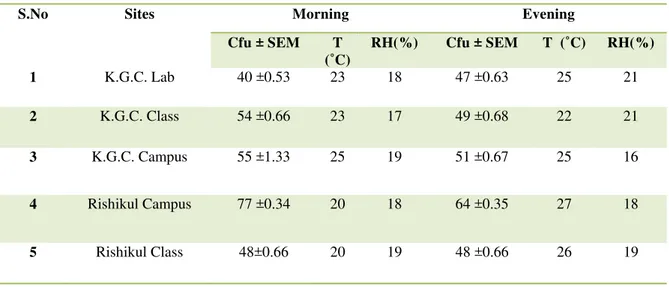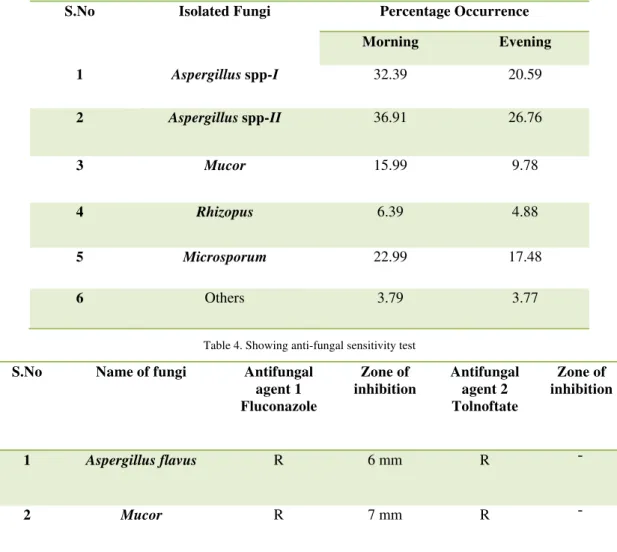Atmospheric biopollutants of fungal origin
in different educational Institutes and their
allergenic behaviour.
Padma Singh*,S Priyanka Chaudhary and RainaDepartment of Microbiology, Kanya Gurukul Campus, Gurukul Kangri University, Haridwar-249407
E.mail: dr.padmasingh06@gmail.com; priyanka.chaudhary817@gmail.com Abstract
Air is an essential part of our environment. The microbial population of atmosphere at any place constitutes its “air spora”. Air contains many fungal spores but their number and type depends on time of the day, weather, season and geographical location. The present study deals with the incidence of viable and cultural mycoflora in the atmosphere of different educational institutes of Haridwar. In view of the fact that air borne fungal spores are one of the main causative factors for allergy in human beings. Trapping and identification of various air borne fungal spores was done. Exposed plate method (EPM) was employed for trapping aeromycoflora using both SDA and CDA medium.The temperature and humidity were also recorded at the time of sampling. The most dominant fungi recorded during air monitoring in the morning was Aspergillus spp I (36.91%) followed by Aspergillus spp II (32.39%), Microsporum (22.99%), Mucor (8.06%), Rhizopus (6.32%) and others (3.79%). In the evening, the percentage occurrence of fungi recorded were Aspergillus spp I (26.76%) followed by Aspergillus spp II (20.59%), Microsporum (17.48%), Mucor (6.84%), Rhizopus (4.88%) and others (3.77%) respectively. Fungi isolated are known to have pathogenic effect on human health including various allergic disorders such as allergic rhinitis, bronchial asthma and atopic dermatitis.
Keywords: Airspora, Biopollutants, EPM, Air monitoring, Allergens. 1. Introduction
The atmosphere is the gaseous envelope surrounding our planet, exceeding to a height of 200 Km. As air is the basic amenity of life for respiration and breathing, man inhales about 50 lbs of air a day to sustain his requirement for oxygen. Alongwith life giving gaseous, atmosphere consists of an array of bioparticles such as bacteria, virus, fungal spores. These are commonly inhaled with different types of allergic manifestations such as running nose, breathlessness, sneezing. These type of hypersensitivity to these bioaerosols is called allergy. Many human allergic diseases such as asthma and seasonal allergic rhinitis are attributed to inhalation of air borne fungal spores and pollen grains.
Fungi are a diverse group of organism comprising both single celled and multicellular filamentous forms. Fungi are ubiquitous in nature found in all possible habitats such as soil, decaying vegetables, wood, damp walls etc. and more than 80,000 spp. of fungi are known to occur [1]. Fungal spores are present in indoor and outdoor environment and comprise major component of suspended biological particles of air. They are liberated in very high concentration and can remain suspended in air over extended periods of time due to the small size (3-100µ). Thus, when inhaled the susceptible individuals suffer different types of allergic manifestation. The common allergic symptoms of fungal allergy are respiratory allergy, conjunctivitis, atopic dermatitis, hayfever, asthma, eczema etc.
2. Experimental
2.1. Sampling sites and time: Five different sampling sites belonged to two different educational institutes named Kanya Gurukul Campus and Rishikul Ayurvedic College, Haridwar (India) were selected for the study of aeromycolora. The sampling was done at different times in the morning (8 am-10 am) and evening (4pm -6pm) and data was recorded.
2.2. Isolation of aeromycoflora - Expose Plate Technique [2]:
2.3. Enumeration and Identification of fungal flora:
After incubation period, fungal colonies appeared were enumerated and identified by morphological characteristics [3,4] and lactophenol cotton blue staining. The percentage occurrence of individual fungal spp was calculated by using formulae:
Percentage occurrence: No. of colonies of individual spp. in all the plates x 100 Total no. of colonies of all species
2.4. Antifungal sensitivity:
Antifungal sensitivity of dominant fungi isolated was calculated by Agar Well Diffusion Assay in which 0.1 ml of 5mg/ml of antifungals (Flucanozole and Tolnaftate) were inoculated in wells made by punching cork borer (5mm) in medium mixed with fungal culture. The plates were then incubated at 28±20C for 5 days.
2.5. Statistical analysis:
All the experiments were carried out in triplicates and results were calculated as the mean ± standard error (S.E.).
3. Results:
3.1.Enumeration of fungal colonies in the morning: In Kanya Gurukul Campus, maximum colonies were found in outer campus area (55±1.33) followed by classroom (54±0.66) and lab (40±0.53) while in Rishikul Ayurvedic college, maximum CFU was calculated at Campus area (77±0.31) followed by class room(48±0.66) (Table 1).
3.2.Enumeration of fungal colonies in the evening: In Kanya Gurukul Campus, maximum colonies were found in outer campus area (51±0.67) followed by classroom (49±0.68) and lab (47±0.63) while in Rishikul Ayurvedic college, maximum CFU was calculated at Campus area (64±0.35) followed by class room(48±0.66) (Table 1).
3.3.Identification of fungi: The identified fungi at both the sampling sites were Aspergillus spp I, Aspergillus
spp. II, Mucor, Rhizopus, Microsporum etc. and the maximum percentage occurrence was recorded for
Aspergillus spp.I and II in morning and evening samples both (Table 2).
3.4. Antifungal sensitivity: It was found that both the dominant fungal species Aspergillus and Mucor were found resistant to both the antifungals utilized, Flucanozole and Tolnaftate with 6 and 7mm zone of inhibition respectively.
Table 1. Survey of fungal population at different educational Institutes of Haridwar.
S.No Sites Morning Evening
Cfu ± SEM T (˚C)
RH(%) Cfu ± SEM T (˚C) RH(%)
1 K.G.C. Lab 40 ±0.53 23 18 47 ±0.63 25 21
2 K.G.C. Class 54 ±0.66 23 17 49 ±0.68 22 21
3 K.G.C. Campus 55 ±1.33 25 19 51 ±0.67 25 16
4 Rishikul Campus 77 ±0.34 20 18 64 ±0.35 27 18
Table 2. Showing percentage occurence of individual fungi in K.G.C. and Rishikul area of Haridwar
Isolated Fungi
K.G.C Lab K.G.C Class K.G.C.
Campus
Rishikul Campus
Rishikul Class M - E M - E M - E M - E M - E
Aspergillus spp -I 31.25 - 19.29 00.00 - 18.46 33.33 - 24.59 46.75 - 21.25 17.74 - 19.40
Aspergillus spp -II 37.50 - 29.82 45.45 - 23.07 37.03 - 24.59 00.00 - 25.00 27.41 - 31.34
Mucor 10.04 - 08.77 18.18 - 10.76 18.51 - 09.83 12.98 - 07.50 11.29 - 10.44
Rhizopus 06.25 - 03.50 09.09 - 06.15 07.40 - 00.00 06.49 - 05.00 04.83 - 08.95
Microsporum 00.00 - 19.29 00.00 - 15.38 00.00 - 19.67 29.87 - 16.28 16.12 - 16.41
Others 00.00 - 01.75 00.00 - 04.61 00.70 - 00.00 03.98 - 05.00 00.00 - 00.00 M – Morning;E- Evening Average of 3 replicates
Table 3. Percentage occurence of fungal flora in different educational Institutes.
S.No Isolated Fungi Percentage Occurrence
Morning Evening
1 Aspergillus spp-I 32.39 20.59
2 Aspergillus spp-II 36.91 26.76
3 Mucor 15.99 9.78
4 Rhizopus 6.39 4.88
5 Microsporum 22.99 17.48
6 Others 3.79 3.77
Table 4. Showing anti-fungal sensitivity test
S.No Name of fungi Antifungal
agent 1 Fluconazole
Zone of inhibition
Antifungal agent 2 Tolnoftate
Zone of inhibition
Fig.1. Showing fungal population in morning and evening at different sites.
Fig.2. Histogram showing meteorological data record of relative humidity and temperature at different sites in Morning and Evening. 40
54 55
77
48
47 49 51
64
48
0 10 20 30 40 50 60 70 80 90
K.G.C. Lab K.G.C. Class K.G.C. Campus Rishikul
Campus
Rishikul Class
Morning Evening
23 23
25
20 20
18
17
19
18 19
25
22
25
27
26
21 21
16
18 19
0 5 10 15 20 25 30
K.G.C. Lab K.G.C. Class K.G.C. Campus Rishikul Campus Rishikul Class
Fig.3. Histogram showing percentage occurence of fungi in morning and evening
Discussion:
The microbial population of atmosphere at any place constitutes its “air spora”. These are to be the causative agent of various allergic disorders such as allergic rhinitis, bronchial asthma and atopic dermatitis. In India, 10% of human population suffer from major allergic disorders in which 5-15% contributes to fungal allergy. More than 80,000 fungal spp are known to occur and most of them are cosmopolitan in nature. The survey of aeromycoflora was carried out at different educational institutes of Haridwar. The fungi trapped from different locations were belonged to Deuteromycetes and Zygomycetes. According to morning data, Aspergillus spp I with 36.91 percentage occurrence was found to be dominant followed by Aspergillus II (32.39%), Microsporum
(22.99%), Mucor (8.06%), Rhizopus (6.32%) and others (3.79%). Similar results were observed for evening samples. Singh and Khanna [5] also studied the aeromycoflora of Yogi Pharmacy (Haridwar) while in the study conducted by Singh and Parashar [6], the presence of Aspergillus niger (16.83%) as the dominant fungi was observed. A study on soil fungi in El Beida by El Gali [7] showed that the most abundant genera were
A.alternata, A. niger, Fusarium spp and Penicillium spp.
During the study, sensitivity of dominant fungi was also calculated, in which both the species were found resistant to both the antifungals. Also, both temperature and pressure provide positive approach to increase the fungal colonies at evening hours. Rainfall and relative humidity almost always have profound effects on the level of fungi spores [8,9].
Conclusion:
The present study deals with the study of incidence of viable and culturable aeromycoflora in the atmosphere of different educational institutes of Haridwar. In view of the fact that airborne fungal spores are one of the main causative factors for allergy in human beings, trapping for identification of various airborne fungal spores was done. This preliminary study has gathered ample information as the kinds of aeroallergens occurring in area due to fungal origin at public places. The death and decaying organic materials, animal products and plants contribute to fungal propagules into the atmosphere and the presence of Aspergillus flavus is also not considered safe as it is known to produce aflatoxins, which are causative agent of cancer.
References:
[1] Hawksworth D.L., B.C.Sutton and G.C.Ainsworth. Dictionary of the fungi.CAB International, Kew, 1983,Pp 30-31
[2] Asan, A.,Sen, B., Erkara, I.; Filik, C., Cabuk, A. Airborne fungi and actinomycetes concentration in the air of Eskisehir City (Turkey). Indoor Built Environment, 2002, 13: 63-74.
[3] Barnett H., Hunter B. Illustrated genera of imperfect fungi, 4th ed., APS press, St. Paul, Minnesota, 1998.
[4] Ellis, D., Davis, S., Alexiou, H.,Handke, R. and Bartely, R. Descriptions of medical fungi. Second Edition. Adelaide, Australia, 2007. [5] Singh P and Khanna R. Study on aeromycoflora of Yogi Pharmacy. M.Sc. Project work. Department of Microbiology. Gurukul Kangri
University, Haridwar, 1999.
[6] Singh P. and Parashar S. Studies on aeromycoflora of Haridwar. M.Sc. Project work. Department of Microbiology. Gurukul Kangri University, Haridwar,2006.
[7] El-Gali, Z.I..Comparison of natural soil sterilization methods and their effects on soil inhabitant fungi. Nat. Sci.,2014, 12(4):72-78. 32.39
36.91
15.99
6.39
22.99
3.79 20.59
26.76
9.78
4.88
17.48
3.77
0 5 10 15 20 25 30 35 40
Aspergillus spp‐I
Aspergillus spp‐II
Mucor Rhizopus Microsporum Others

